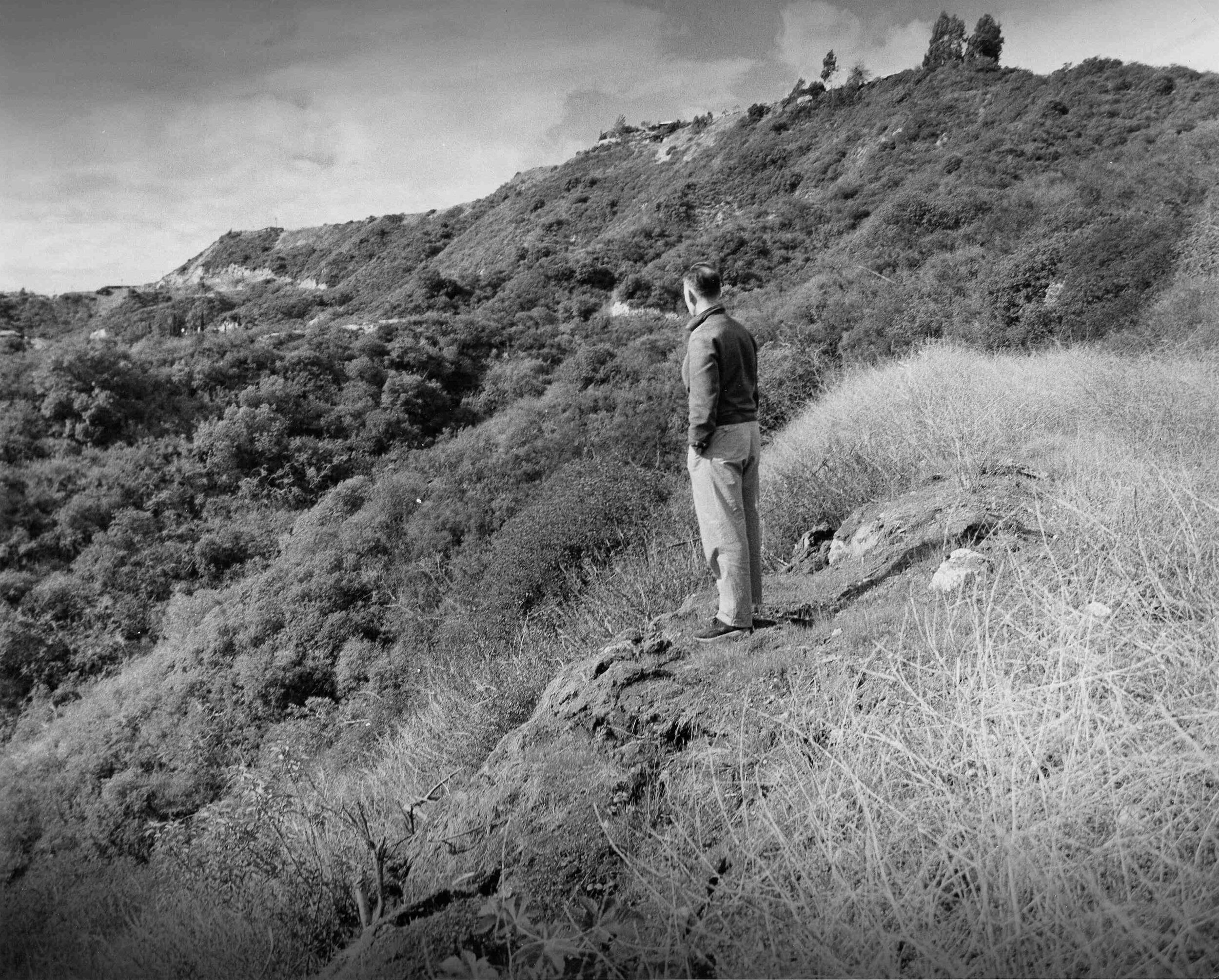Monson’s Before Zorada Rds Completion, Julius Shulman (1959)
Nestled in the Hollywood hills, Nichols Canyon extends three miles from Hollywood Blvd. to Mulholland Drive. Our Canyon is an urban oasis in sprawling Los Angeles. Deer, coyotes, and a myriad of animals also call the Canyon home. Nichols Canyon is favored by hikers, cyclists, and nature lovers. Celebrity residents enjoy its privacy and seclusion with easy city access. It’s beloved resident artist David Hockney titled his iconic 1980 painting “Nichols Canyon.” Modern, post-modern, Spanish, and traditional homes line Nichols Canyon as well as a sparkling creek that runs for 1.3 miles, fed by two waterfalls. Sycamore, Acacia, Laurel Sumac, Avocado and California Holly fill the canyon, hosting brilliant bird life including owls and red-tailed hawks. Each season is celebrated with changing foliage and animal life. During spring the sound of frogs is ever present in the creek and by winter they give way to birds making their annual pilgrimage through our canyon.
Nichol’s Canyon is named for John G. Nichols, the mayor of Los Angeles from 1852 to1853 and again from1856 to 1859. He was a businessman and a builder who lived in the first brick house built in Los Angeles. In 1849, Nichols led a caravan of 100 wagons from Jackson County, Iowa, to Southern California. He guided his passengers through the infamous Donner pass without incident of cannibalism, and was later rewarded for his bravery and leadership with 160 acres by the United States much of which included what is now Nichols Canyon.
Until In 1884 Nichols Canyon had been a large sheep ranch, when the first settler Jacob Miller and his wife Dorothy bought seventy acres and built their ranch house in 1879 at the foot of the hills just about where Hollywood Boulevard now crosses Ogden Drive. Dorothy planted the first avocado trees to survive in Los Angeles. Dorothy’s uncle owned a nursery in downtown Los Angeles and imported many rare plants from the tropics which did not grow well at his Main street nursery. They did however thrive in the Canyon, the nearby soil and climate offered a fertile environment, so he gave her many unusual plants and seeds that she carefully nurtured. The area became known as Miller Canyon.
Images from left to right: Nichols Canyon, David Hockney (1980), John G. Nichols, the mayor of Los Angeles from 1852 to1853 and again from1856 to 1859, Jacob Miller circa 1879.
The name Miller Canyon lasted only a year as the old Miller Farm had been replaced decades before by the Hollywood Granite Company. “Miller” Canyon was the only attempt to challenge the original Nichols name though not its acreage. At the turn of the century, Daniel Desmond, the founder of Desmond’s apparel store, bought up half interest in the canyon not owned by the Nichols family. Even though the Desmonds never tried to change the name they did name a small cove of land Courtney Avenue and Courtney Terrace after Daniel’s oldest son, who had tragically died.
In the mid 1920’s the Desmond sisters hired a young surveyor to prepare the cove for a group of family villas. His first day on the job Frank Lloyd Wright Jr. came down with such a severe case of poison ivy that he was bedridden for two weeks. The Desmonds hired another surveyor and eventually a cluster of elegant Mexican style red tiled roof homes were built in the area off Nichol’s Canyon near Hollywood Boulevard.
A few years earlier in 1918 Arthur Letts, an immigrant from England who later founded the Broadway department store, donated ten acres for the Boy Scouts. It was used until the 1950’s when it was sold by the Boy Scouts for development, with the exception of a small ¼ acres strip which contains a memorial to JB Lankershim who also donated the land.
Until 1929 Nichols Canyon was a dirt road, much of the grading paid for by private land owners. At that time the City Council voted on the paving of Nichols Canyon Road to Mulholland Drive. Improvements such as sewers, water, gas, lights, and storm drains were built and installed.
In 1941 the Nichols Canyon Development Sales office operated out of an old western style type porch and roof overhang approximately ¾ miles up the canyon. Children played in the stream while adults negotiated property deals.
Throughout the years, specifically in1904, 1956, and three years later in 1959, Nichols Canyon experienced devastating brush fires. Flooding was also problematic with two incidences in 1913 and 1931. Diligent homeowners proactively pursued city assistance resulting in a debris basin as well as mandatory brush clearance to help prevent fires. In addition, homeowners work to ensure that overbuilding does not swallow up our magnificent canyon.
Today Nichols Canyon remains a sanctuary in Los Angeles. The Nichols Canyon Neighborhood Association is critical in protecting this precious way of life for enjoyment of all and for future generations. The canyon is beloved by so many. Echoing the words of early resident Dorothy Miller: … we loved the hills and our beautiful canyon and were happy in our home and family."
Images from left to right: Miller Ranch, Nichols Canyon north of Hollywood Blvd (1879), Zorada Bend, Julius Shulman (1959), Sailor looking south on Zorada, Julius Shulman (1959).






